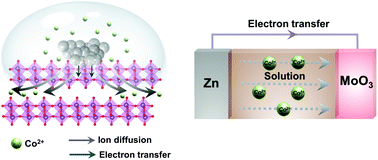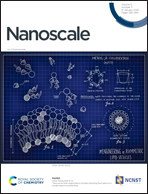A self-driven approach for local ion intercalation in vdW crystals†
Abstract
Intercalation has proven to be a powerful strategy for physical and chemical property modulation in two dimensional (2D) van der Waals (vdW) materials. Traditional gaseous and chemical intercalation methods offer the ability for mass production, and the electrochemical method provides reversible fine tuning for in situ material investigation. Spatial control, or even direct patterning, of ions is widely required for practical device fabrication and integration; yet it is not realized. Here we demonstrate a self-driven ion (Co2+, Sn4+, and Cu2+) intercalation approach with patterning ability on vdW α-MoO3. It is proved that the self-driven intercalation was enabled by the formation of a local galvanic cell and could be controlled by the metal electrode potential and the solution concentration. The universality of self-intercalation was confirmed in various types of 2D materials (MoS2, WS2, MoSe2, WSe2 and graphene). Furthermore, the feasibility of building heterostructures by multiple species (Sn & Co) intercalation in a single nanosheet was demonstrated for broadband photodetection. The enhancement of conductivity and photoresponse was found to be due to the synergistic effect of lattice distortion from Sn intercalation and the d orbital from the Co atom. This approach offers a feasible way for direct nano-fabrication in 2D vdW material and functional device integration.



 Please wait while we load your content...
Please wait while we load your content...